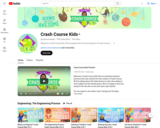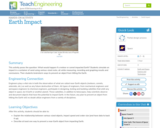
This site offers a 360 view of Mars from the Mar’s Curiosity rover.
- Subject:
- Science
- Material Type:
- Activity/Lab
- Homework/Assignment
- Author:
- NASA
- Date Added:
- 04/02/2020

This site offers a 360 view of Mars from the Mar’s Curiosity rover.

The purpose of this lesson is to introduce students to the planet Mars. This lesson will begin by discussing the location and size of Mars relative to Earth, as well as introduce many interesting facts about this red planet. Next, the history of Martian exploration is reviewed and students discover why scientists are so interested in studying this mysterious planet. The lesson concludes with students learning about future plans to visit Mars.

Antimatter, the charge reversed equivalent of matter, has captured the imaginations of science fiction fans for years as a perfectly efficient form of energy. While normal matter consists of atoms with negatively charged electrons orbiting positively charged nuclei, antimatter consists of positively charged positrons orbiting negatively charged anti-nuclei. When antimatter and matter meet, both substances are annihilated, creating massive amounts of energy. Instances in which antimatter is portrayed in science fiction stories (such as Star Trek) are examined, including their purposes (fuel source, weapons, alternate universes) and properties. Students compare and contrast matter and antimatter, learn how antimatter can be used as a form of energy, and consider potential engineering applications for antimatter.

The year is 2032 and your class has successfully achieved a manned mission to Mars! After several explorations of the Red Planet, one question is still being debated: "Is there life on Mars?" The class is challenged with the task of establishing criteria to help look for signs of life. Student explorers conduct a scientific experiment in which they evaluate three "Martian" soil samples and determine if any contain life.

This site explores the elements of art and principles of design with videos, examples and lessons.
The elements and principles of design are the building blocks used to create a work of art.
Elements of Art are the visual "tools" that artists use to create an art work - they are what makes up an image or an art object: line, shape/form, value, color, space, and texture.
Principles of Design are the ways artists use the Elements of Art in an artwork - this is "what we do with the Elements" - how we arrange them, how we balance them, what is being emphasized, etc. The principles are: balance, contrast, repetition, emphasis, and unity.
Be sure to check out Art 2 - Lesson plans for intermediate Art program @ https://resourcebank.ca/courses/art-1-lesson-plans-for-beginner-art-program

Art 2 offers a two semester program:
Semester 1
Focus on drawing skills:
creative drawings, shading techniques review and practice, pen and graphite drawings, texture shading, colored pencils and oil pastels techniques, design stylizing techniques, non-traditional art media, mix-media, introduction to watercolor pencils, watercolor techniques, etc.
Semester 2
Focus on drawing, painting and printing media:
unusual painting media, creative designs - practice eye-hand coordination, pen and ink drawings, pattern values and creative application, introduction to silk screen printing, optical illusions and OpArt - review perspective, collages and acrylic paintings, composition and colors in Art.
Be sure to check out Art 1 - Lesson plans for intermediate Art program @ https://resourcebank.ca/courses/art-1-lesson-plans-for-beginner-art-program-2

In this lesson, students learn some basic facts about asteroids in our solar system. The main focus is on the size of asteroids and how that relates to the potential danger of an asteroid colliding with the Earth. Students are briefly introduced to the destruction that would ensue should a large asteroid hit, as it did 65 million years ago.

"Find out what it's like on other planets. Learn how far away the stars are. Try a fun, space-themed project."

When we look at the night sky, we see stars and the nearby planets of our own solar system. Many of those stars are actually distant galaxies and glowing clouds of dust and gases called nebulae. The universe is an immense space with distances measured in light years. The more we learn about the universe beyond our solar system, the more we realize we do not know. Students are introduced to the basic known facts about the universe, and how engineers help us explore the many mysteries of space.

Rockets need a lot of thrust to get into space. In this lesson, students learn how rocket thrust is generated with propellant. The two types of propellants are discussed and relation to their use on rockets is investigated. Students learn why engineers need to know the different properties of propellants.

This collection of activities is based on a weekly series of space science problems distributed to thousands of teachers during the 2009-2010 school year. They were intended for students looking for additional challenges in the math and physical science curriculum in grades 9 through 12. The problems were created to be authentic glimpses of modern science and engineering issues, often involving actual research data. The problems were designed to be åÔone-pagersåÕ with a TeacheråÕs Guide and Answer Key as a second page. This compact form was deemed very popular by participating teachers.

Students create and decorate their own spectrographs using simple materials and holographic diffraction gratings. A holographic diffraction grating acts like a prism, showing the visual components of light. After building the spectrographs, students observe the spectra of different light sources as homework.

Education for Innovation Resources
Rideau Hall Foundation (RHF) has resources called: Education for Innovation:Grades 1-8 and Education for Innovation: Grades 7-12.
These resources provide activities educators can use to help students develop innovation skills applicable to all subjects and sectors, from science and technology to arts and social sciences.
RHF is an independent and non-political charitable organization that fosters a culture of innovation in Canada by celebrating our national accomplishments as well as providing a platform for innovators to grow and connect. The education resource guides are available for free download at: www.canadianinnovationspace.ca.

The Canadian Space Agency site has lots of fun stuff for students including fun experiments, fun stuff, podcasts, quizzes and more.

The Celestia Motherlode is a repository for various addons like textures, models or celestial objects for Celestia. Celestia is a free, interactive (real-time), 3D astronomy program. It doesn't just show you the sky as it can be seen from earth as most planetarium software does, but allows you to move to and view the universe from any point between the planets and the stars. The Celestia Motherlode hosts over 10 GB of Celestia addons by various creators, which extend or change the way Celestia renders the universe.

This resource contains an abundance of ELA infused, cross-curricular lessons organized by themes for Grades 4, 5 and 6. Non-fiction, poetry and fiction reading lessons are all included.

Crash Course Kids combines the same engaging lecture-style content delivery with animated graphics that focus on grade school science.
Topics include Earth Science, Physical Science, Biology, Geography, Engineering, and Astronomy.
These videos are amazing!

Students find and calculate the angle that light is transmitted through a holographic diffraction grating using trigonometry. After finding this angle, student teams design and build their own spectrographs, researching and designing a ground- or space-based mission using their creation. At project end, teams present their findings to the class, as if they were making an engineering conference presentation. Student must have completed the associated Building a Fancy Spectrograph activity before attempting this activity.

Students acquire a basic understanding of the science and engineering of space travel as well as a brief history of space exploration. They learn about the scientists and engineers who made space travel possible and briefly examine some famous space missions. Finally, they learn the basics of rocket science (Newton's third law of motion), the main components of rockets and the U.S. space shuttle, and how engineers are involved in creating and launching spacecraft.

This activity poses the question: What would happen if a meteor or comet impacted Earth? Students simulate an impact in a container of sand using various-sized rocks, all while measuring, recording and graphing results and conclusions. Then students brainstorm ways to prevent an object from hitting the Earth.